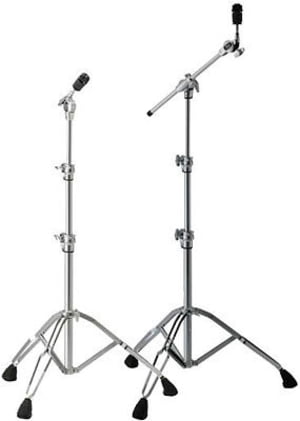6. Hardware
This collective term denotes all items that serve to mount and position the various components of the drum kit: Stands (including the Hi-hat stand and pedal), the bass drum pedal (as described in the section on bass drums), and sometimes a drum rack with mounting brackets.
Rigidity and flexibility are major criteria for evaluating drum hardware. Also, the weight should not be underestimated. Many of today's stands are constructed from light alloys. Heavy stands made of solid metal have mostly been superseded by lighter, double-braced models. The sturdiness of the adjustment screws is another factor, as these must withstand many cycles of intense tightening without the threads wearing out.
We've already described the bass drum pedal. Now, let's look at the Hi-hat stand, snare stand, cymbal stands, tom stands, racks and drum seats.
Hi-Hat stand
Besides the bass drum, the Hi-hat is the second component of the drum kit which is (partly) played by foot. As with the bass drum pedal, the most important criteria are the smoothness of the mechanism and its durability. By means of a push rod and a set of springs, the Hi-hat stand suspends the top cymbal a short distance above the bottom cymbal. By stepping on the pedal, the Hi-hat is closed and the top cymbal is lowered onto the bottom cymbal, thereby creating the typical "chick" sound. When the pedal is released, the springs return the upper cymbal into its starting position.
Cymbal stands

Straight cymbal stand, boom stand
In contrast to the bass drum and Hi-hat pedals, cymbal stands are part of the non-moving, stationary hardware. A typical beginner's kit comes with one straight cymbal stand and one boom stand. Boom stands allow for closer and more flexible positioning of the cymbals within the drum kit. However, the farther the cymbal is placed from the stand's center of gravity, the less stable the structure will be. Consequently, boom stands require a larger floor area. Cymbal arms, which can be attached to existing stands, can be an alternative to adding additional stands.
Tom stands
In most standard drum kits, the suspended toms are attached to a holder mounted on the bass drum, while the floor tom has its own legs. In case the bass drum lacks a mounting point for toms, special tom stands are available. Up until the 90's, many drummers even preferred to mount the floor tom on a tom stand, instead of placing it on its legs. Combined stands for a tom and a cymbal are also available.
Drum racks
Drum racks are usually associated with big drum kits containing a large number of tom-toms and cymbals. They are constructed of metal tubing and let you attach all toms and cymbals to a single frame instead of placing them on individual stands. One advantage of this system is that all elements have a fixed position, which can remain the same even when transporting and reassembling the kit. Also, the floor space is less cluttered than with individual stands, which is especially useful for the placement of microphones. Racks are also popular with electronic drums.
Drum throne
Most beginner's kits do not include a drum stool or throne. Due to budget constraints, many beginners choose the cheapest model they can find. While this is fine, you should consider that you might end up sitting on the throne for many hours at a time, once you're infected with drum fever. In this case, an uncomfortable seat will soon become a hindrance. If multiple players share the same seat, an easily adjustable model is a practical solution.


